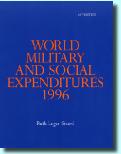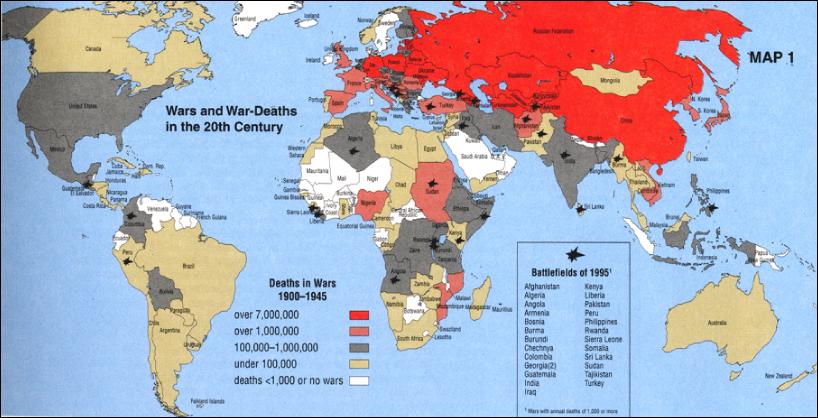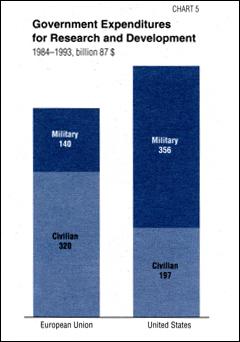Ruth Leger Sivard's |
||
 |
|
Home___Publications___Background___Contact |
|||
| |
||||||
World Military and Social Expenditures by Ruth Sivard |
|
 |
|||
With four years still to go, this modern century has already been responsible for 250 wars and 109,746,000 war-related deaths, a number somewhat larger than the total current population of France, Belgium, Netherlands, and the four Scandinavian countries, Denmark, Finland, Norway and Sweden. Since mid-century, wars have become more frequent and much more deadly. There have been six times as many deaths per war in the 20th century as in the 19th. Increasingly, civilians are the major victims of war. In the first half of this century they represented about 50 percent of war-related deaths. In more recent years, however, the proportion of civilians in total deaths has been rising. Wars are now more life-threatening for non-combatants than for those fighting them. In the 1960s civilians accounted for 63 percent of the recorded war deaths; in the 1980s for 74 percent; and in the 1990s the rate seems to be going higher still. Technology The death and destruction associated with modern war owe much to the development and wide dissemination of advanced military technology. Aided by the enormous sums governments provided for military equipment, the art of warfare has been radically transformed. In the industrial countries, procurement, including research and development (R&D), represents about one-third of their annual military expenditures. Since their military budgets in the 1990s still average well over $500 billion a year (current dollars), this fraction means an investment of more than $150 billion a year in weapons of war. (By comparison, that is considerably more than developing nations pend in a year for the education of the 800 million children they have enrolled in school.) While today’s wars are fought largely by developing countries, most are armed with equipment representing 20th century advances in technology and mainly produced by industrial countries. Between 1960 and 1994, arms imports of developing countries amounted to $775 billion (1987 dolllars), or 69 percent of the total trade in arms. Their purchases continue to be the major factor in sales in the international arms market, although by the mid-1990s, under increasing pressure by aid donors, their arms imports had declined to less than one-quarter of the peak in the mid-1980s. A further shrinkage in sales to the developing countries, along with the virtual disappearance of any competition from the former USSR, may help to slow the pace of military R&D in the industrial countries. The data available for those countries indicate that since 1970 military R&D has absorbed more than half of all publicly-supported research funds, exceeding research expenditures for the entire spectrum of economic-social needs for which governments have responsibilities. So far, there has been no major R&D cutback, in large part because most of the research on weapons is now sponsored by the US, which continues to be actively engaged (see chart 5 below). At a cost of $356 billion (1987 dollars) or military R&D in just 10 years, the US has not only maintained its Number One position in nuclear and conventional weapons technology, but ha also produced an array of mind-boggling marvels or war-fighting -wicked killers such as: an artillery rocket with a yield of 2,000 tons of TNT; the gatling gun with a rate of 3,000 rounds per minute; intercontinental ballistic missles which travel at a speed of 15,000 miles per hour. The pace of innovation in weapons has no counterpart in civilian R&D. Yet these military spellbinders may hold some interest for civilians who, after all, represent the endangered bystanders of future wars. It may be small comfort to them to know that the extremely costly “smart” bombs, when used in the Persian Gulf War, did not always deliver the bang for the bucks spent on them. Economy The world’s economic growth has been much faster in the second half of the 20th century than in the first half. Estimates suggest that on a per captita basis the overall growth rate in this half century may be more than double what it was before 1950. In the earlier period, th economy had to contend with two world wars and a war-related death toll of 89,000,000 people. In this half century, war deaths (so far) have been below 22,000,000, one-quarter of the death toll before 1950. Based on that record, we might say that peace (or even relative peace, with fewer war casualties) is good for the economy. But what does that tell us about the effects of military expenditures on the economy? Actually, very little. The connections between economic growth and excessive military expenditures are not simple, and it is important to note that the diversion of resources to military defense, or to war, represent only part of a broad spectrum of factors affecting progress. Certainly, in size and influence, the military establishment became a more powerful feature of the economy after World War II. Available estimates indicate that the military claim on government budgets may now be well over ten times greater (in constant dollars) than it was before the war. The standing armies are much larger than they were 50 years ago, despite the technological miracles which havegiven the average soldier mobility and firepower infinitely greater than his predecessor. And the arms industry has become a multinational, military-industrial complex, with considerable influence inside government and, often. first claim on the public treasury. Despite the heavier military burden, the growth of the gross national product in the second half of the century was unusually strong. Among the factors favorable to growth, especially in the decades immediately following World War II, were: new international institutions to promote economic development (e.g. FAO, IMF, World Bank), an increased flow of capital to developing countries, collective action by governments specifically to foster growth, and the global expansion of education. These and other prescriptions for economic health resulted in a significant advance in the global economy. By 1955, the world’s gross national product, after allowance fo inflation, was more than triple the size of the economy in 1960, when systematic world-wide record keeping began. The growth of the economy also exceeded the rapid rise in population, producing a per capita GNP twice as large as in 1960. Social Protection From the point of view of social development, progress has been slower than overall economic growth might suggest. The broader objectives of development do not flow automatically from an expanding global economy. Those objectives include a fair distribution of the benefits of growth among the people and progress in promoting social equity, which at a minimum calls for the alleviation of poverty, the provision of employment, and the satisfaction of basic needs. Progress in those terms depends on the level of GNP attained and the distribution of that income, but also on public policy and government spending priorities. The broader view shows a rich economy still seriously deficient in terms of equity. The benefits of growth since 1960 have not appreciably altered the lot of the poorest in the world population. From 1960 to 1994 the average gain in real income per capita was 22 times larger in the industrial countries than in the developing regions of the world. ($10,530 per capita versus $480 in the developing countries.) The continued imbalance in social development is further emphasized by the contrasts in government priorities. The clearest indication we have of the investment committed to social objectives is in the allocation of funds through public budgets. In the size and relative emphasis of their budget expenditures, governments affect future as well as current standards of living. They also have an impact on the distribution of the fruits of progress. The assurance of at least a primary education and basic health-care for all have been the major goals of development, for which governments have taken responsibility. Public education and public health budgets have grown significantly in recent decades. On a per capita basis, global education expenditures are now more than three times as large as in 1960, health expenditures more than five times as large. There is still a vast gap, however, between the industrial and developing countries in their social expenditures, and this difference is also reflected in attainment levels. In 1993, expenditures for public education in current dollars were $1,202 per capita in industrial countries and $37 in developing, representing a ratio of 32 to one. Public health expenditures were $1,376 per capita in industial countries, $22 in developing, a ratio of 63 to one. Contrasts in the resources available open a window to the very different living conditions within the 20th century world of great wealth and power. Education can help to break the vicious cycle of poverty and desperation. But the gap between needs and budgets available in developing countries still leaves 900 million adults illiterate, 130 million children who are not in primary school. Effective health protection can make an enormous difference not only in the individual life but for the community at large. As a social investment it has a positive, multiplier effect on the economy. But life expectancy in the poorer countries is still 14 years shorter than in the richer; infant mortality rates ten times as high. These extreme contrasts in living conditions are unlikely to disappear until the developing countries have the resources to invest in them. An initial sharp reduction in their military expenditures would be one step in the right direction. Savings of even 20 percent from swollen military budgets could bring 189 million more children into primary and secondary school systems and would be a non-pareil guarantee of further progress in social development. |
||
 |
||
 |
||||
Chart 5 While the US government devoted 72 percent of its total research budget frome 1984 to 1993 to military objectives, European countries had quite different priorities. The major share of their official research expenditures in those 10 years went to civilian needs- i.e. health, education, energy, food- and only 28 percent to military programs. |
||||
Overview by Ruth Sivard
As the 20th century races to a close, it already stands out as the most productive and destructive century on record. No other comes close to it in terms of social progress- in the education, health and wealth it has provided for the population. Yet it is also evident that no other century on record equals the 20th in uncivilized civil violence, in the number of conflicts waged, the hordes of refugees created, the millions of people killed in wars, and the vast expenditures for “defense”.